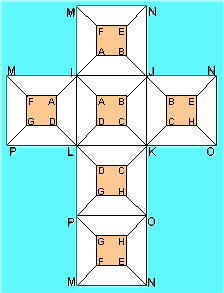The network represents a map of the edges and vertices of a
hypercube or more precisely, a tesseract when imposed within 2D space.
 |
The orange squares represent the faces of the internal cell, a cube in 3D space, and is defined by vertices A to H. The larger bolder letters, I to P are the vertices of the outer cell/cube.
The diagonal lines are the edges which link the inner to the outer forming the faces that configure the cells which interface to the inner and outer cells.
Let each hypercell have a value which is the vertex sum of each of its enclosing faces (or three times the sum of its 8 vertices).
|
The vertices are to be numbered uniquely from 1 to 16, and for consistency of reference, let
A always be 1.
Find sets of values for A through P so that all the cells have the same value.
Note: while the on-line calculator may be useful, a spreadsheet should prove more valuable for those able to use one.
(In reply to
1 solution, program running for remaining by Daniel)
thanks for pointing out my error, I made a slight mistake in my program that allowed some duplicates. Fixed it and got the following answer
a=1,b=7,c=15,d=16,e=13,f=11,g=2,h=3,i=6,j=4,k=9,L=10
m=14,n=12,o=5,p=8
With cell sum of 204. Currently letting program run to count all possible solutions
|
|
Posted by Daniel
on 2009-02-03 02:00:17 |




